Empowering Freedom With Assistive Modern Technology for the Blind
The combination of assistive technology for people that are aesthetically damaged or blind stands for a substantial innovation in cultivating freedom and improving quality of life. With a variety of devices-- from display viewers to ingenious responsive devices-- these modern technologies not only promote navigating and communication however likewise advertise social addition and involvement in numerous facets of life.
Understanding Assistive Innovation
Although assistive modern technology has actually developed significantly for many years, its fundamental function stays the very same: to boost the top quality of life for individuals with handicaps, especially those who are visually impaired or blind. This technology incorporates a broad series of tools and gadgets that facilitate self-reliance and capability in day-to-day activities.
Assistive modern technology can be classified right into modern and low-tech services, each made to meet particular requirements. State-of-the-art devices typically consist of software program applications, specialized hardware, and adaptive devices that utilize innovative technology to offer support in different contexts. Conversely, low-tech services may include daily items that are modified to improve ease of access, such as magnifiers or tactile markers.
The integration of assistive technology into the lives of people that are blind or visually harmed not just promotes freedom yet also fosters social incorporation and involvement in academic and expert settings. By leveraging these modern technologies, customers can navigate their environments, accessibility info, and interact effectively, thereby boosting their total top quality of life. Recognizing assistive technology is vital for professionals, advocates, and caretakers who aim to support individuals in maximizing their possible and attaining better self-reliance.
Kinds Of Assistive Instruments
Assistive tools for the blind and aesthetically impaired are crucial devices that enhance daily obeying addressing details challenges come across by users. These gadgets can be extensively categorized into 3 primary types: optical gadgets, digital devices, and sensory devices.

Sensory devices, such as Braille screens and tactile maps, provide alternate ways to obtain info. Braille displays convert electronic text right into Braille, allowing users to review touch. Responsive maps provide spatial understanding with increased lines and textures, allowing for far better environmental understanding.
Together, these assistive gadgets equip people with visual impairments to engage more completely with their environments, advertising greater self-reliance and self-confidence in daily tasks.

Influence on Day-to-day Live
The integration of assistive innovation into the everyday lives of people that are aesthetically damaged or blind significantly improves their capacity to engage and browse with the globe around them. Tools such as display readers, Braille displays, and mobile applications help with accessibility to information, allowing users to engage with digital web content, communicate successfully, and handle everyday tasks separately.
Moreover, modern technologies like clever glasses and navigating applications offer real-time support in unknown environments, enhancing mobility and self-confidence. These devices allow users to identify obstacles, read signs, and even recognize faces, hence cultivating a feeling of freedom in public rooms. Furthermore, home automation systems, which can be managed with voice commands, permit people to manage their living environments better, improving comfort and safety and security.
The influence of assistive modern technology prolongs beyond sensible tasks; it advertises social incorporation and psychological wellness. By bridging the void in between people and their surroundings, these technologies encourage individuals to get involved totally in neighborhood activities, seek academic chances, and engage in purposeful connections. Ultimately, the improvement of assistive innovation contributes in redefining the opportunities for individuals that are visually damaged or blind, leading to an extra comprehensive and obtainable culture.
Success Stories and Reviews

One more effective testimony originates from Mark, a recent college graduate that utilized screen reading software program throughout his scholastic trip. This innovation allowed him to access course materials and join discussions, ultimately causing his effective change into the workforce. Mark credit histories assistive modern technology for encouraging him to achieve his occupation objectives, stressing its duty in leveling the having fun field for people with aesthetic disabilities.
Furthermore, recreation center have actually reported raised participation in their programs many thanks to the introduction of accessible digital platforms. These platforms have made it easier for individuals to link, share resources, and support one another. These success stories collectively underscore the extensive effect of assistive technology in fostering freedom, enhancing lifestyle, and breaking down obstacles for the blind and aesthetically impaired area.
Future Fads in Assistive Tech
Arising technologies are positioned to change the landscape of assistive technology for individuals that are visually damaged or blind. Technologies in expert system (AI) and maker knowing are improving the directory capacities of gadgets, making it possible for more intuitive customer experiences. As an example, AI-driven applications are significantly able to acknowledge objects and review message out loud in real-time, supplying customers with important info concerning their surroundings.
Additionally, improvements in wearable technology are creating new chances for freedom. Smart glasses geared up with enhanced truth functions can overlay critical info onto the individual's visual field, assisting in navigation and communication with the setting. Furthermore, the integration of Web of Things (IoT) devices is enhancing access in clever homes, permitting users to control devices and obtain alerts through voice commands or responsive user interfaces.
The growth of braille display screens and tactile feedback systems is also on the rise, advertising accessibility to electronic content and boosting interaction. As these modern technologies continue to develop, they guarantee to boost everyday living, academic opportunities, and employment potential customers for individuals with aesthetic problems. Constant cooperation in between engineers, individuals, and advocacy teams will be necessary in making certain these technologies fulfill the requirements of the community efficiently.
Conclusion
To conclude, assistive modern technology plays a critical role in improving the independence of people that are aesthetically impaired or blind. By supplying important tools and resources, these innovations help with boosted accessibility, navigating, and communication to info, thus cultivating autonomy and positive self-image. The transformative effect of assistive tools not just promotes reliable communication with the atmosphere yet likewise motivates social inclusion and participation in various facets of life, inevitably equipping individuals to flourish within their communities.
The combination of assistive technology for individuals who are blind or aesthetically impaired stands for a significant innovation in promoting freedom and enhancing high quality of life.The combination of assistive modern technology into the lives of people that are blind or aesthetically impaired not only promotes autonomy however additionally cultivates social inclusion and participation in academic and specialist environments. Ultimately, the advancement of assistive innovation is crucial in redefining the opportunities for people that are blind or aesthetically damaged, leading to an extra comprehensive and obtainable society.
Many individuals who are blind or aesthetically impaired have actually shared motivating success tales that highlight the transformative influence of assistive technology on their lives.In conclusion, assistive modern technology plays a crucial duty in boosting the independence of people that are blind or aesthetically impaired.